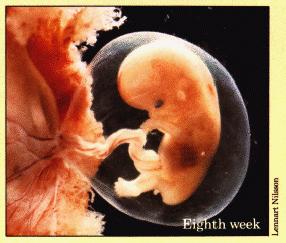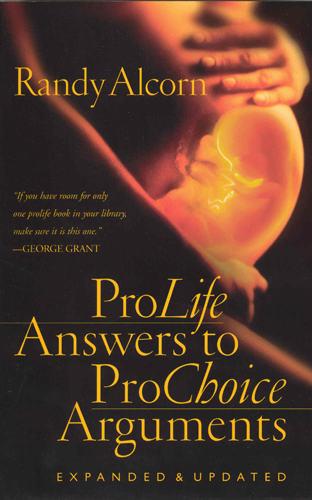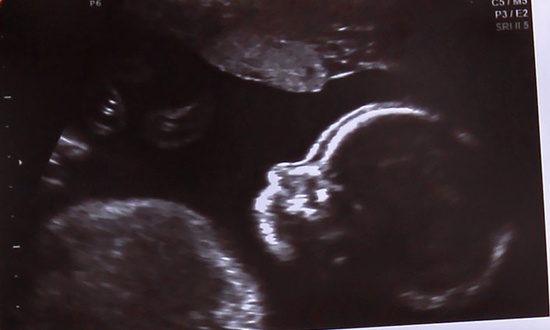The following article is excerpted from Ron’s presentation at colleges that presents a moral perspective on the beginning of life geared toward a secular audience.
When it comes to the choice of abortion we are faced with a most fundamental question: Is an innocent person injured? If not, then abortion isn’t much different than an appendectomy or a gall bladder removal and society and government should keep their noses out of what truly is a personal decision. If, however, an innocent party suffers injury or death, then we should be unapologetically opposed to abortion.
So is anyone hurt by abortion? That is the great debate. We know that a fetus dies in an abortion. Dr. Warren Hern, a director of Boulder Abortion Clinic in Boulder, Colorado, is the author of the abortion “how to” manual, Abortion Practice. In it he says an abortionist may, in some second trimester procedures, have to wait to make certain “fetal death has occurred” before continuing with the rest of the abortion process (Abortion Practice, J. B. Lippincott Co. 1990, p. 154). We know something dies in an abortion. But does someone die?
That question can only be answered by ascertaining the difference between a thing and a person. What is it that sets a person apart from everything else? Imagine your favorite human. If someone were to question his or her personhood how would you prove he or she truly is a person? It’s not as easy as it might first appear.

Defining personhood, then, becomes crucial in determining who we value and protect. The U.S. Supreme Court stated as much in its Roe v. Wade decision: “If the suggestion of personhood is established, the appellant’s case [to legalize abortion], of course collapses, for the fetus’ right to life is then guaranteed specifically by [the fourteenth] amendment” (Roe v. Wade, 410 U.S. 113, 1973, p. 38). The Fourteenth Amendment says the state shall not deprive any “person” of life without due process of law.
Aside from the fact that killing an innocent person is unconstitutional it is also morally repugnant to decent folks. So in order to legitimize abortion it has become necessary to define personhood narrowly enough to exclude fetuses (Latin for “little ones”) killed in abortion. A number of criteria for determining personhood have been proposed in the last several decades.
Appearance
Carl Sagan tackled the problem by implying preborn humans in early gestation lack personhood because they don’t look human.
“By the third week...the forming embryo is about 2 millimeters long and is developing various body parts. But it looks like a segmented worm...By the end of the fourth week...it looks something like a newt or a tadpole...By the sixth the reptilian face has connected slits where the mouth and nose would eventually will be. By the end of the seventh week...the face is mammalian but somewhat pig-like. By the end of the eighth week, the face resembles a primate’s but is still not quite human (“Is It Possible To Be Prolife and Prochoice?,” Parade Magazine, 22 April 1990, p. 6).
The problem with this approach is it is extremely subjective. Some might say Carl Sagan looked a bit reptilian. But how utterly unscientific it is to say because an individual looks animal-like he is something less than a person.
This dehumanization was used to rationalize slavery in the United States for many years. Afro-Americans were said to look “monkey-like” and, therefore, less than human. This attitude was backed up by the Supreme Court’s 1857 Dred Scott decision which said, “A black man has no right which the white man is bound to respect” (Roger B. Taney, cited by James C. Dobson and Gary L. Bauer, Children at Risk, Waco, Tex.: Word Publishing, 1990, p. 141). In essence, our country needed certain people to be less than human because we wanted to do something inhumane to them.
This approach was used against European Jews in the 1930s and 40s. They were referred to as “vermin” and “insects” to make their extermination palatable.
Intelligence
This category consists of several elements. Joseph Fletcher, a Medicine professor from University of Virginia, proposed a number of “indicators” of personhood:
- a minimum IQ ( less than 40 and you are questionable, less than 20 and you are definitely not a person)
- self-awareness, sense of time
- self-control
- sense of the future
- sense of the past and ability to relate to others (“Indicators of Humanhood: A Tentative Profile of Man,” The Hastings Center Report 2, Nov. 1972, p. 1)
At first glance these criteria for personhood might seem reasonable. Shouldn’t a person have some sort of personality? Wouldn’t this mean a certain amount of intelligent awareness and ability to relate?
The trouble with these criteria is they don’t apply to an entire class of people we know are persons, namely the comatose. A while back my friend, Bob, was injured in an accident and was in a coma for four days. I was privileged to be with him when he started coming out of the coma. His family and friends wept for joy as he asked questions like, “Where am I?”, and “What happened?” During those four days Bob had no self-awareness, no sense of time, no self-control, no sense of past or future and definitely no ability to relate to others. His IQ could not be measured. But he was still Bob the human, Bob the person, Bob the husband, Bob the daddy and Bob my friend. He was treated as a person because he was a person.
The problem with defining personhood by some standard of intelligence is that it is completely arbitrary. Who has been given the insight and wisdom to say that an IQ of 40 is acceptable but 39 is questionable? Who has the supreme authority to say that a human must perform at a given intellectual level before he or she is deemed a someone?
Some say that an individual becomes a person at a certain stage of physical development. A few use viability as a starting point. Viability is the age of the “little one” when he or she is capable of surviving outside the mother. The trouble with using the age of viability (anywhere from about 20 to 24 weeks) as a determiner is that “viability depends not only on the child but on [our] ability...to save its life” (Randy Alcorn, ProLife Answers to ProChoice Arguments, Portland, Oregon, Multnomah Books, 1994, p. 63). Can we honestly say that the nature and worth of a child at twenty-one weeks depends on whether or not it is born in a hospital with enough technology to save her life?
An additional problem with viability is that it is so vague in another way. Most children, born at the so-called age of viability, can’t live on their own without an abundance of medical help. So are they truly viable? And what about full-term newborns? They, too, need a tremendous amount of care to live outside the womb. What really is viability? And even if viability were an exact point in time (which it isn’t), why would anyone think that’s the age you become a person? Why not say it happens in the fourth week when your heart beats? Or the sixth week when your brainwaves are measurable? Or when you first respond to light and noise? (Alcorn, p. 62) Certainly viability is no more significant to your personhood than any of these other stages of maturity.
Thinking Ability
Carl Sagan offered yet one more stage of development where the line between person and nonperson could be drawn.
“...brain waves with regular patterns typical of adult human brains do not appear in the fetus until about the 30th week of pregnancy...Fetuses younger than this—however alive and active they may be—lack the necessary brain architecture. They cannot yet think...Regular brain waves are rarely found in fetuses...If we wanted to make the criterion still more stringent, to allow for precocious fetal brain development, we might draw the line at six months (Sagan, p. 7,8). Whether you’re measuring IQ or brainwave patterns, the decision to draw the line at a given point is purely arbitrary. Mr. Sagan tipped his hand when he says “...we might draw the line at six months”. After all the rationale is presented, this argument really gets down to choosing a personhood beginning point to suit ones fancy.
Desirability
In Portland, Oregon, local abortionist, Jim Newhall, revealed his ideas about personhood. He said, “Not everybody is meant to be born. I believe, for a baby, life begins when his mother wants him” (as cited by Maureen O’Hagan, “Cross Hairs to Bear,” Willamette Week, 3 May 1995). When he says “life” it is assumed Newhall means “personhood”. He could not mean simple biological life since he is in the business of terminating life on a daily basis. The absurd yet inevitable result of his view is that the unborn could move in and out of personhood each time the mother changed her mind about whether or not she wanted her baby.
Using appearance, intelligence, maturity, thinking ability or desirability to determine personhood is tempting. A later personhood date allows abortion to become a benign surgical procedure which injures no one. It becomes a harmless way to solve the problem of an unwanted pregnancy. But this is the kind of reverse logic we sometimes tend to fall into when trying to solve a pressure packed problem. We start with a solution, a conclusion, a place we want to end up. Then we look for ways to get there while still keeping our sense of personal morality in tact. It’s called rationalizing. At the same time we tend to reject information that would prohibit us from doing what we think is necessary to achieve our goal. This is especially true when we are looking back to a decision which has already been made. When looking at abortion, the last thing we want to consider is information that would lead us to believe we participated in the killing of a child. Who wants to face that? This distancing oneself from information is called denial. Rationalization and denial are methods we use to cope with unwanted and stressful information. However both hinder a clear view of reality.
Looks, aptitude, age, size, intelligence and personality don’t determine when a person begins. These are merely attributes which describe already existing persons.
Real Personhood
So, what is a person? A person is simply a live human, a living, individual member of the human species.
A live human. Unlike a finger or a gall bladder which are parts of a person, a person is an entirely unique individual taking up his or her own space.
A live human. In terms of the legal right to life, a person must be physically alive. A live human. A person is not a feline, a canine, a bovine or an equine but a human, a member of the species, homo sapien.
Think about your own life. When did it begin? When did you become you? It happened when you became a live human and that occurred at conception. Like an idea which begins when it is conceived, so an individual life begins when he or she is conceived. At conception dad’s sperm unites with mom’s ovum and something incredible happens. The union forms a single cell with an entirely new genetic code. This new cell, a zygote, contains enough information to fill fifty sets of encyclopedias (Alcorn, p. 47). All of this information is on a kind of time release. Some is released almost immediately as the zygote divides, grows and becomes an embryo. Other information is released later along the road to maturity, first in utero, then as an infant and on through adulthood. In the early teen years an explosion of changes occurs with the triggering of puberty. Still other information delays going into effect until later in life when, for some, that first gray hair appears or that extra weight becomes more difficult to lose.
The problem is it’s difficult to think of a single-celled human zygote as a person. Can you really have a one-celled person? The answer is a definite yes and here’s why. Let’s say the number of cells in your body right now is represented by the value x. At an earlier age, when your cell count was 1/2x or 1/20x or 1/2,000 x, you were just as much the unique and distinct person you are now. You were simply smaller and younger. The same principle applies when you were made up of 1,000 cells, 100 cells or one cell. You were still you. Remember the size of a human, that is the number of cells in a human body, does not determine personhood. You do not become a human being through cell division. Put another way, “something nonhuman does not become human by getting older and bigger” (Alcorn, p. 54).
At the age when you were just a single cell, you were small, immature and difficult to relate to. The same could be said about you when you were a newborn. When you think about it, some adults can be described as immature and difficult to relate to. That’s the point, humans come in all sizes, ages, levels of intelligence and types of personality. Appearance, intelligence, maturity, and desirability are just descriptive terms which show the amazing diversity of the human race.
Conclusion
The bottom line is this: person is synonymous with human being. Every human, every person begins his or her life at the beginning, at conception.
When we talk about the choice of abortion we are talking about killing an existing person. Children about to be aborted are, admittedly, quite young, small and helpless. So helpless, in fact, that none of them has any means of defending against his or her own death. But lack of protest by a victim does not justify the victim’s destruction.
To be prochoice on abortion, you would have to ignore the medical and scientific evidence for personhood. Either that or hold a world view that allows the killing of innocent people. Trying to solve problems by killing children is insane, isn’t it? For most, killing a child by abortion requires a self-induced numbness. The anesthetic comes in numerous forms of rationalization: “parenting will ruin my future, my boyfriend will leave me, I couldn’t face my family and friends, there’s no way I could give up my baby for adoption, the world is overpopulated...”
The numbness, however, lasts only a short while. Eventually the tingly prickles of reality awake us to the fact of our personal participation in the killing of a little girl or boy. This world is full of problems some of which seem overwhelming. Let’s solve our problems without harming innocent people. We can do it. We must do it. There is no other choice.
For more information on this subject, see Randy Alcorn's book, ProLife Answers to ProChoice Arguments.





